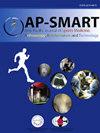使用无代码深度学习应用程序检测和分类肩部磁共振图像上的冈上肌病变
IF 1.4
Q3 ORTHOPEDICS
Asia-Pacific Journal of Sport Medicine Arthroscopy Rehabilitation and Technology
Pub Date : 2025-05-05
DOI:10.1016/j.asmart.2025.04.005
引用次数: 0
摘要
目的评价无代码深度学习(CFDL)在肩核磁共振成像(MRI)图像上诊断冈上肌腱病变的性能。设计:本回顾性横断面研究纳入冈上肌MRI显示部分或全层撕裂和肌腱萎缩的患者,对照组为表现正常的患者。在LobeAI应用程序中使用迁移学习与ResNet-50 V2进行模型开发,对MRI图像进行处理。建立模型以区分每种病理与正常撕裂和全层撕裂与部分撕裂。结果使用LobeAI应用程序建立的ML模型能够区分正常肩关节MRI图像与部分撕裂、全层撕裂和肌腱病,敏感性分别为93.75%、100%和100%,特异性分别为43.75%、62.5%和18.75%。该模型用于对部分和全层泪液进行分类,准确率为34.38%。与正常MRI图像相比,纳入所有病理图像的模型的准确率为37.50%,加权F1评分为0.32。结论本研究的结果表明,尽管CFDL应用于冈上肌病变的初步检测可能是有希望的,但其目前的迭代存在局限性,必须在可靠地整合到临床实践之前加以解决。本文章由计算机程序翻译,如有差异,请以英文原文为准。
Detection and classification of supraspinatus pathologies on shoulder magnetic resonance images using a code-free deep learning application
Objective
To evaluate the performance of a code free deep learning (CFDL) application in diagnosing supraspinatus tendon pathologies on shoulder magnetic resonance imaging (MRI) images.
Design
This retrospective cross-sectional study included patients with supraspinatus MRI showing partial or full-thickness tears and tendinosis, with patients having normal findings as the control group. MRI images were processed in the LobeAI application using transfer learning with ResNet-50 V2 for model development. Models were built to differentiate each pathology from normal and full-thickness tears from partial tears.
Results
The ML models developed using the LobeAI application demonstrated the ability to differentiate between normal shoulder MRI images and partial tears, full-thickness tears, and tendinosis with sensitivities of 93.75 %, 100 %, and 100 %, respectively, and specificities of 43.75 %, 62.5 %, and 18.75 %. The model designed to classify partial vs. full-thickness tears achieved an accuracy of 34.38 %. The model incorporating all pathological images compared to normal MRI images exhibited an accuracy of 37.50 % and a weighted F1 score of 0.32.
Conclusion
The results of the study suggest that, although CFDL applications may be promising for the initial detection of supraspinatus pathologies, their current iteration has limitations that must be resolved before they can be reliably integrated into clinical practice.
求助全文
通过发布文献求助,成功后即可免费获取论文全文。
去求助
来源期刊
CiteScore
3.80
自引率
0.00%
发文量
21
审稿时长
98 days
期刊介绍:
The Asia-Pacific Journal of Sports Medicine, Arthroscopy, Rehabilitation and Technology (AP-SMART) is the official peer-reviewed, open access journal of the Asia-Pacific Knee, Arthroscopy and Sports Medicine Society (APKASS) and the Japanese Orthopaedic Society of Knee, Arthroscopy and Sports Medicine (JOSKAS). It is published quarterly, in January, April, July and October, by Elsevier. The mission of AP-SMART is to inspire clinicians, practitioners, scientists and engineers to work towards a common goal to improve quality of life in the international community. The Journal publishes original research, reviews, editorials, perspectives, and letters to the Editor. Multidisciplinary research with collaboration amongst clinicians and scientists from different disciplines will be the trend in the coming decades. AP-SMART provides a platform for the exchange of new clinical and scientific information in the most precise and expeditious way to achieve timely dissemination of information and cross-fertilization of ideas.

 求助内容:
求助内容: 应助结果提醒方式:
应助结果提醒方式:


